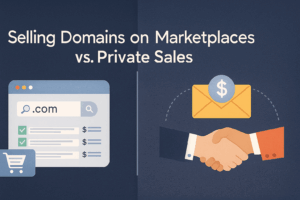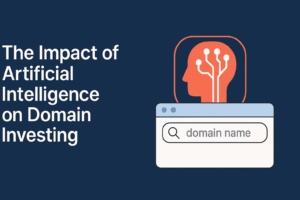Brand Ranking Traditional Advice Wrong

The digital age has allowed small companies to take the big guys head on. Most websites now look very similar. This is no longer a significant advantage. How a brand ranks against the competition impacts sales, conversion and growth potential. Our minds rank brands to help us create simplicity. If your advertising or brand does not connect with your customer the message goes to the stronger brand on the ladder. You can actually be spending money to increase your competitor’s sales. Your domain name or brand is now a quick way to differentiate and move up the brand ladder.
Take a deeper a look at the psychology of branding and domains
Why companies experience higher conversions online is certainly a complex discussion with many facets. If you look at it like a building, your domain and brand are foundational elements that impact many aspects of your growth strategies. Let’s look at a quick at what I mean:
- Does your brand make sense for your product?
- Do you own the domain for your brand? This creates an effortless path for your customers to interact with you online.
- How does your brand compare to the competition when you stack it up in search?
Would Jet.com have been as successful if they were called JetPack.com? Would Microsoft have been better to be called Microhard? The internet now adds a new dimension because you may not own your brandable domain online. For example, what if Apple had to use GetApple.com because an apple orchard owned Apple.com.
Certainly, money solves many issues and if a company wants to spend enough on advertising they can surmount this incongruence with their domain name not matching their brand. If you go even deeper, brands are now ranked in search based on algorithms.
I need to discuss the domain I own!
Most of your consumers will never see your brand in a silo. We are forced to make split second decisions and rank brands based on numerous factors. Based on my research and having visited over a hundred thousand sites, your domain is a significant factor in how you rank against the competition. How your brand ranks in this split-second decision is important because it leads to conversion and sales.
In most categories, technology has leveled the playing field allowing for smaller companies to appear almost identical to larger companies. Company culture and experience do play a large part in conversion however this too is can be replicated. Your domain strategy is an important foundational element of your brands success online.
A Brand’s domain name is an important element into the ranking process.
The first interaction with most brands is online and in search. You are looking for a product so you do a search and 15 to 17 companies show up stacked on top of each other. Consumers now need to make quick split second decisions on which of these 17 companies are relevant. How do they do this in a category that could be unfamiliar to them? Check out this search example for “email encryption service”. This is ranked in the same order as on the search page.
- ShareFile.com
- AppRiver.com
- ZixCorp.com
- Barracuda.com
- Sendinc.com
- ProtonMail.com
- DataMotion.com
- Entrust.com
Keep in mind most of the copy and headlines are the same. The one differentiating factor is the brand and domain. Which company are you going to trust to encrypt your sensitive and maybe top secret emails? How do you think a brand with domain Encrypt.com would be ranked against these competitors? Microsoft conducted two research studies on this subject and proved that the domain strongly effects the consumer’s decision, especially when the consumer isn’t familiar with the search engine results.
This split-second decision has real world consequences for conversion, sales and profit.
The hierarchy of effects developed by Lavidge
Here is a classic brand awareness and hierarchy guide from Lavdige in the 1960’s. There are many different models however they are similar in structure. The difference between now and the 1960’s is the speed in which we travel thru this hierarchy. The internet has allowed us to have massive amounts of information which I believe have condensed the time to move thru the first three steps.
- Stage 1: Awareness – The consumer becomes aware of a category, product or brand (usually through advertising)
- Stage 2: Knowledge – The consumer learns about the brand (e.g. sizes, colours, prices, availability etc)
- Stage 3: Liking – The consumer develops a favourable/unfavourable disposition towards the brand
- Stage 4: Preference – The consumer begins to rate one brand above other comparable brands
- Stage 5: Conviction – The consumer demonstrates a desire to purchase (via inspection, sampling, trial)
- Stage 6: Purchase – The consumer acquires the product
The digital age has allowed small companies to take the big guys head on.
Technology advances have made it easy for smaller startups to look like the category leaders. Often when I am visiting websites in my marketing outreach I am amazed at how similar they look. Most even use the same site map groups. If you just looked at the top sites without brands it would be almost impossible to differentiate companies.
Years ago, brands with larger budgets stood out because they could add a higher degree of development for of their site. Today because of the advancement in technology and the ease of coding with programs like ClickFunnels this is no longer an advantage.
This is great news for the startup. At the same time, it needs to put the category leaders on notice.
Your domain name or brand is now a quick way to differentiate and move up the brand ladder
We are saturated with marketing messages today. Our brain needs to simplify these messages and is forced to make quick decisions. Your domain, brand and product name do have an impact into how consumers rank you against the competition. Determine how you will position yourself against the competition. Does your brand sound too much like the competition? If the competitor is ranked higher on the brand ladder than your brand you run the risk of your marketing having a positive halo effect to them.
The internet has changed the rules of how small companies can jump up the brand ladder. They can do this by owning the keyword this connects with consumer intent. The storefront is your website and tech has made this a non-advantage for most companies. Ask yourself these questions regarding your brand and domain
- What position do you own in the prospects mind?
- What companies do you need to pass to get to that position?
- Will your domain/brand allow you to go there?
- What is your marketing plan to accomplish this gain?
Advances in technology have created incredible opportunities for businesses. The internet has allowed small businesses and startups to take on category leaders like no time before in history. Domain strategies are an important foundational element of your brands success online. Understanding the psychology behind the brand awareness and hierarchy guide will help you choose the perfect domain to outrank your competition. Send us an email and let us know how we can help with your domain acquisition.



